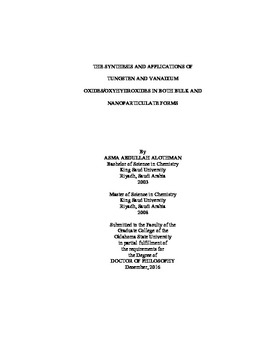| dc.description.abstract | The reactions of tungstic acid towards alkenes, alkynes, and nitriles were explored in order to determine the scope of its reactions with unsaturated hydrocarbons. The chemistry was found to be complex with small changes in substrates leading to significant changes in the products produced. Most reactions, but not all, resulted from strong acid catalysis. Dehydrogenation, dimerization, cyclotrimerization, oligomerization, and hydration reactions were observed. Single-step reactions to produce useful triazenes or to convert light petroleum fractions to diesel fuel, the Jacobsen rearrangement of alkyl benzenes, and the first non-enzymatic retro benzoin condensation were discovered. The products have potential applications in organic synthesis, industry, and medicine. The reduction of colloidal suspensions of vanadium bronze were found to produce suspensions of vanadium bronze nanoparticles while reactions with bulk materials produced bulk bronzes. Bimetallic oxides and oxyhydroxides of vanadium combined with aluminum, zirconium, yttrium, and lanthanum were successfully obtained through reaction of the aqueous vanadyl oxalate and the corresponding metal oxide or hydroxide. These materials have important applications in catalysis, pigments, and explosive sensing. In the latter respect, sensing systems for hydrogen peroxide detection utilizing colloidal vanadium bronzes, vanadyl solutions, and thin film of vanadium oxide materials were developed. Thin films of V10O24-12H2O were made successfully from a nanometric suspension of the material produced by reduction of peroxovanadic acid by oxalic acid. This film showed electrical conductivity and stability for long periods of time. All of the vanadium-containing systems tested showed rapid dramatic colors change after exposure to hydrogen peroxide exposure. Supporting the materials on porous alumina surfaces resulted in a significant enhancement of the sensitivity towards peroxide. Two of these sensing systems showed exceptional promise for sensor development due to their ability to regenerate their original color after hydrogen peroxide exposure ends. Kinetic analysis of color regeneration found it to be a first order reaction. The resting states of these two catalytic systems are the blue reduced vanadium compound. When exposed to hydrogen peroxide the materials adopt the red coloration of a vanadium hydroperoxide complex but once removed from hydrogen peroxide, the blue color slowly regenerates as the red color fades. | |
